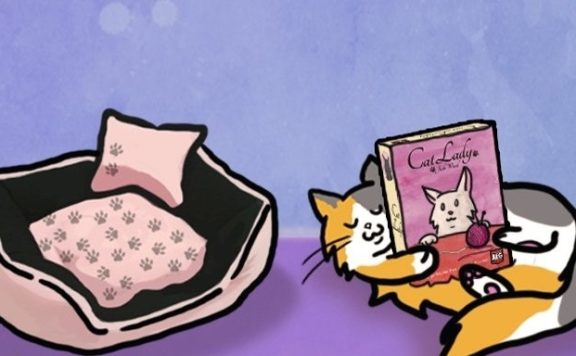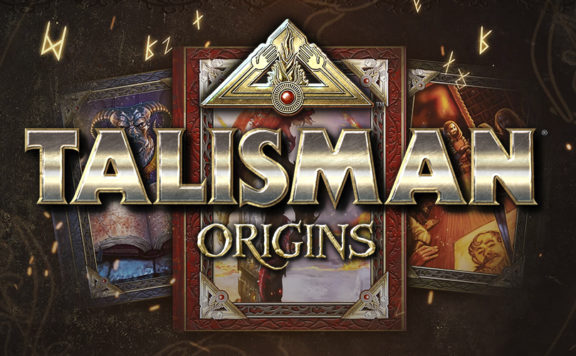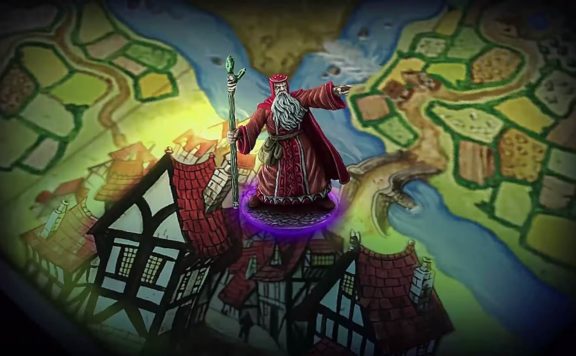Fighting Fantasy, a truly revolutionary series of adventure novels, is 35 years old this year. Beginning on Firetop Mountain, the brainchild of Ian Livingston and Steve Jackson crashed through the Citadel of Chaos and then continued to rack up a staggering volume of sales across the 1980’s. Now, Nomad games are bring these iconic adventures to PC and mobile gamers with a new interactive RPG experience, Fighting Fantasy Legends.
Carl Jackson – Nomad Games
When is the Fighting Fantasy Legends due for release?
We’re currently looking at you possibly late June so it’s about two three months away from them. It’s about seventy five percent complete. We just need to polish little bits here. The main maps are complete. You can travel across the land of Allansia, travel to different towns, get healing or rest in taverns, take carriage rides between the towns, and delve into the books themselves in the relevant locations.
Fighting Fantasy novels have appeared as PS Vita games in the past, what makes this version different?
What we’re doing isn’t necessarily direct copy of the game books. It’s a roleplaying game based on the events of the books. We do have the places where the descriptions and the stories in the books appear, to get you into the narrative of what’s happening. Most of this text is taken straight from the book so the feel of the books is definitely there. Rather than describing everything we like to let you see those things. We don’t necessarily need to say you want to go this way. Instead we’ll have movement icons.

Has there been many significant changes to translate the game onto mobile and PC platforms?
The fact that it is a card game is a huge change. So for instance, travelling through Firetop Mountain, there might be a room with an Orc or a Goblin in there and what we’ve done is we’ve taken a lot of the iconic things that happen and turned those into a deck of cards. There are various locations throughout the maps where you have to draw a card. There is a deck of cards which is themed to the location you’re in so they could be monsters treasures, events, or even traps. Your character has to deal with those cards before they move on.
Does this mean that the game has a less linear progression than the written adventures might?
The game is actually designed mainly for replayability. So when you when you play through Firetop Mountain, you may not discover everything you need before you fail or lose or get lost. Your character never actually dies. If you lose all of your health it’s a bit more like a roguelike game. You get to restart the level, you’ve learnt something, and possibly got some useful items. You go running back there and maybe go a different route next time but it’s still random things that are happening in those rooms.
That sounds a lot like marking your page in the physical books just in case you die.
Absolutely, I’m well aware that that’s what most people do and they play these games with their fingers between different pages just to see what the alternatives would be.
How much pressure did you feel, when creating the game, to stick to the books original concepts?
Well the pressure is there but that’s only because you know this is a well loved thing. People have great memories of these books and can remember the artwork and what happened. We need to try and create a very similar and familiar experience. In the screenshot here, we find this room, for instance, has some gambling dwarves around a table, and that’s in the book . They can offer you help to guide you through a maze or you could join in and gamble, like you can in the books but we’re presenting it slightly differently.
So, there is certainly a pressure to to make a game that people enjoy, which is the case whenever you make a game. Hopefully people who are fans of the books be looking forward to it.

So I lose all of my clothes with dwarves?
You can certainly loose all your money, although it depends on a number of things. In the book you do a luck or skill test to determine the outcome but we use our dice system. You can upgrade your dice and you have a certain number of luck dice on the left hand side of the screen. When your character levels up you can improve your chances of succeeding in a luck or skill test.
Are there any other elements to that that kind of progression model you’re introducing?
It is simply upgrading the dice, but then we use the dice in lots of different ways. So, for instance, one of the cards that you draw may say that you’ve been robbed by a pickpocket and it will be one roll of your luck dice and lose one gold piece for every blank you roll so therefore the more you upgrade your luck dice the less chance of you rolling a blank so it was a moment. There are elements of that where we’ve used the dice are slightly different ways. But you can still go gambling and lose all your money, just like real life.
How much play time can we expect out of this tile, bearing in mind it has been designed to be replayable?
Well it’s based on three different books and I would say each point to to discover everything you’re probably looking at two to three hours per book. There’s also a card collecting element in it so you have a creature codex, which is a bit like a scrapbook, pokedex type of thing. You have all these blank pages and each time you kill a monster you get a stamp in your book, and you have to try and fill up all of your codex. It has lots of extra little things like that which obviously wouldn’t exist in the book. For example, as your character kills monsters and completes quests to gain experience points, you can level up your dice to get extra icons on your dice that give you different effects when you roll them. So, if you were a completionist, it would probably take you a lot longer than six hours.
So you have achievements in the game?
Well kind of, yes. Your character can collect titles. Say you name your character Grognor, if you go gambling and you lose your money you could be Grognor the Unlucky. There’s about fifty different titles to unlock. If you if you kill a dragon you might unlock the title of Dragon Slayer. That’s harking back to the you are the hero element of the books where we’re trying to make the player feel as though the game is reacting to their choices.
![]()
What sort of character creation is available?
The books use dice rolls to determine your skill, stamina, and luck. We’ve done a similar thing, but there are no six sided dice with traditional digits on them. We don’t use that system. Instead you get a set number of points. Your skill and luck starts off on six, your stamina starts on twelve, and you get fourteen points to distribute between those three. So you could load your character with really good luck and terrible stamina, or vice versa, or a mixture right down the middle. A very lucky character may not have very much gold stolen or might do slightly better in the gambling game. A very skillful character might be able to jump across gaps a little bit better, so it’s a slight upgrade to the systems of the books used which is a little bit more traditional now.
What’s been the biggest challenge in translating the books into an interactive environment like this?
The biggest challenge is just trying to keep the feel of the books without overloading the player with text just because. The game books already exist in digital form so what we don’t want to do is give the player something they’ve already played. We’re trying we’re trying to think of new ways to either surprise familiar players or avoid bombarding them with constant text that might be blocking the view of a the game underneath. It’s being fun challenge just to keep the game fresh. Fans of the books will be so familiar with them they’ll feel like they know the best routes through all of the books. We’ve actually introduced reasons why those things won’t work. You can’t just go breezing through by reading a walk though somewhere. You’ve really got to go exploring.
Ian Livingston – Founding Father of Games Workshop and Fighting Fantasy
Does the translation of Fighting Fantasy onto mobile platforms, and the ubiquity of those platforms, allow these titles to stay relevant to a new generation?
Well Fighting Fantasy has survived the test of time. This is the thirty fifth anniversary, I’ve written a new book to celebrate, The Port of Peril and those who grew up with the books and have their own children are passing the baton on. Normally children reject everything to do with their parents but in this case I’m delighted that children are enjoying the branching narrative of with a game system attached to them. In book format there is a resurgence and of course with video games and mobile games it’s ubiquitous, as you say. I think they enjoy the empowerment of being able to explore where they want, making the choices they do, with the consequence of their actions rather than a traditional linear path. This gives them a choice, and kids today love choice.
Do you think this is just a natural progression of a genre that moved from books, to RPG’s like The Witcher series, coming back into the hands of players?
It’s funny you mention The Witcher series. The designer of the game based much of his early scenario work on Fighting Fantasy. I also read recently that the design of Dark Souls was a massive Fighting Fantasy fan and read them read them in Japanese because they’re really hugely popular in Japan. There’s a definitely a ripple of influence that’s emerged from Fighting Fantasy that’s affected a lot of the role playing genre.

We’ve seen up distinct upturn in media coverage of roleplay, on new media formats such as Twitch and Youtube in particular. Why is that?
It’s not just roleplay, but board games that have seen this too. I think a lot of it to do with the social aspects of of boardgames of roleplaying games. That has been missing in some video games and that you’re creating this theatre on the fly as it were. That is very common a compelling to the audiences.
How does it feel to create something that has so much on influence on so many of the people here today?
I am very proud of it. Steve Jackson and I had no idea the impact it would have at the time let alone these days. I meet people all the time who have been deeply impacted by the series and that is humbling and rewarding. It’s great.
I have seen you described as a creator that was forced to learn the business side but like any industry the business side of things is incredibly important. What advice would you give the students coming to Rezzed today looking to break into the industry?
Don’t be afraid of failure. Failure is just successful work in progress. Take your learnings and move on. Try to be yourself. There is so much copying of other people’s ideas that if you if you’re good at what you do and you have a passion about what you do, you will find an audience. Don’t compromise.
How did it feel to write a brand new adventure for Fighting Fantasy?
A lot harder than I thought it was going to be. I started planning Port of Peril a pair of about a year ago and got down to the hard writing of it in December. It’s taken me over three months doing twelve hours a day. My biggest hurdle is almost that I can’t compromise I don’t just get stuff out there. I do it’ to the best of my ability and try to do better than previous books.
Not did you feel that it was more difficult than you remember or was it more rewarding because you had to put in the work.
All of the above. When I write Fighting Fantasy gamebooks love luring people their doom. Sprinkling rose petals along the path where you could end up falling on poison spikes always makes me chuckle. There’s a lot of variety of ways to die and I’ve really enjoyed crafting the world. There’s a lot more interaction with Characters and places than normally. so it’s not a simple question of going into a room, killing a monster, and looting some treasure. There’s a lot of interaction going on with non player characters and building a much more visual description of the world. You do go back to Port Blacksand and Darkwood Forest, where you start off in a new place. What you think is a simple treasure hunt, you soon discover is not.
How important is the artwork to describing the world and to translating it into the game?
I think it’s crucial. Steve and I were very lucky to get some of the best artists of the 1980’s. With Games Workshop which we managed to capture some of the great upcoming talent in the U.K. and I was lucky enough to get Ian McCaig to do the art for four of my book covers, City of Thieves, Deathtrap Dungeon, Forest of Doom, and Isle of the Lizard King. He also did the internal art for Deathtrap Dungeon and City of Thieves and those are just wonderful things of beauty. It’s no coincidence that if you look at the Zamzar Bones in City of Thieves and then at Darth Maul, they were both by Ian McCaig. I think it’s hugely important to have a really detailed atmospheric art.
Carl Jackson – Nomad Games
The artwork in our game needs to be quite scary because I think something people remember from the original book, inspired by the original artwork, could be quite gruesome. They could put some pretty disturbing images in your head, so our game needs to be equally gruesome.





